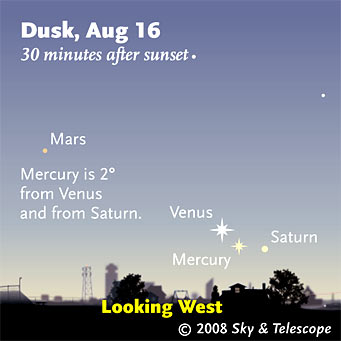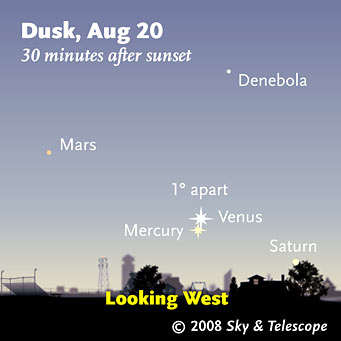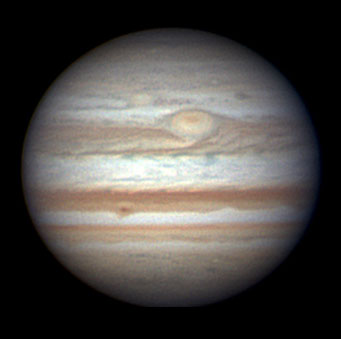Some daily events in the changing sky for August 15 – 23.
Friday, August 15
Saturday, August 16

Keep watching as Mercury closes in on Venus. On the 16th, it's equidistant between bright Venus and faint Saturn (for which you'll need binoculars).
Sky & Telescope diagram
As for North America? It doesn't get even a partial lunar eclipse until June 26, 2010.
Sunday, August 17
Monday, August 18
Tuesday, August 19
This is just the beginning of an amazing series of conjunctions involving four of the five classical planets that continues well into September. Click here to view a one-megabyte movie of the four-planet dance. After watching the general progression, step forward and back to see the configuration on any particular evening. You may need to install QuickTime to watch the film if you haven't already done so.

Mercury and Venus appear closest on the 20th. Mars, meanwhile, is gradually moving toward them from the upper left day by day, and Saturn is fast disappearing to their lower right.
Sky & Telescope diagram
Wednesday, August 20
Thursday, August 21
For a listing of all events among Jupiter's moons this month, visible worldwide, see the August Sky & Telescope, page 58.
Friday, August 22
Saturday, August 23
Want to become a better amateur astronomer? Learn your way around the constellations. They're the key to locating everything fainter and deeper to hunt with binoculars or a telescope. For an easy-to-use constellation guide covering the whole evening sky, use the big monthly foldout map in each issue of Sky & Telescope, the essential magazine of astronomy. Or download our free Getting Started in Astronomy booklet (which only has bimonthly maps).
Once you get a telescope, to put it to good use you'll need a detailed, large-scale sky atlas (set of maps; the standards are Sky Atlas 2000.0 or the smaller Pocket Sky Atlas) and good deep-sky guidebooks (such as Sky Atlas 2000.0 Companion by Strong and Sinnott, the even more detailed Night Sky Observer's Guide by Kepple and Sanner, or the classic Burnham's Celestial Handbook). Read how to use them effectively.
More beginners' tips: "How to Start Right in Astronomy".
This Week's Planet Roundup
Mercury (about magnitude –0.3) is in deep in the glow of sunset, very close to much-brighter Venus as shown in the scenes above. They're just 1° or 2° apart this week. Mercury and Venus will remain within 3° of each other through the end of August. Look with binoculars about 30 minutes after sunset.
Venus (magnitude –3.8) is still deep in the glow of sunset. Look for it just above the west-northwest horizon about 30 minutes after sundown. Fainter Mercury is very close by, as shown above. Saturn, fainter still, is moving away to the lower right day by day. Look too for little Mars to the upper left.
Mars (a dim magnitude +1.7) is low after sunset, roughly a fist-width at arm's length upper left of Venus. Use binoculars.

Jupiter's Great Red Spot was nearing the planet's central meridian when Christopher Go took this stacked-video image at 12:23 UT August 8, 2008. The Great Red Spot remains near System II longitude 127°. To its upper left, the smaller Oval BA ("Red Spot Junior") has already crossed the central meridian. South is up, to match the south-up view in many telescopes.
Click on the image for more views that night, including one resolving Ganymede and one taken in the infrared methane band. Methane in Jupiter's atmosphere absorbs this wavelength — so bright features indicate high-altitude clouds that are above most of the atmosphere.
Jupiter (magnitude –2.6, in Sagittarius) shines brightly with a steady glare in the south after dark. It's upper left of the Sagittarius Teapot and just below the bowl of the smaller, dimmer Teaspoon. It's due south and highest around 9 or 10 p.m. daylight saving time.
Saturn (magnitude +0.8) is sinking away to the lower right of brighter Venus and Mercury in the sunset, as shown in the panels above. Bring binoculars.
Uranus and Neptune (magnitudes 5.7 and 7.8, respectively, in Aquarius and Capricornus) are well up in the southeast by 10 or 11 p.m. Use our article and finder charts.
Pluto (magnitude 14.0, in the northwestern corner of Sagittarius) is in the south right after dark. If you've got a big scope and a dark sky, use our article and finder chart.
All descriptions that relate to your horizon or zenith — including the words up, down, right, and left — are written for the world's mid-northern latitudes. Descriptions that also depend on longitude (mainly Moon positions) are for North America. Eastern Daylight Time (EDT) equals Universal Time (known as UT, UTC, or GMT) minus 4 hours.
To be sure to get the current Sky at a Glance, bookmark this URL:
http://SkyandTelescope.com/observing/ataglance?1=1
If pictures fail to load, refresh the page. If they still fail to load, change the 1 at the end of this URL to any other character and try again.
 0
0
Comments
You must be logged in to post a comment.